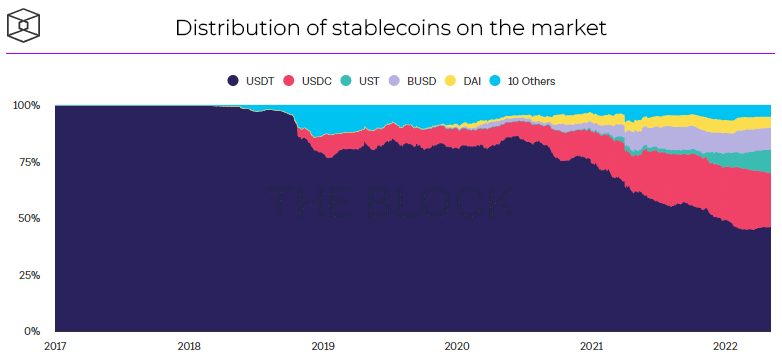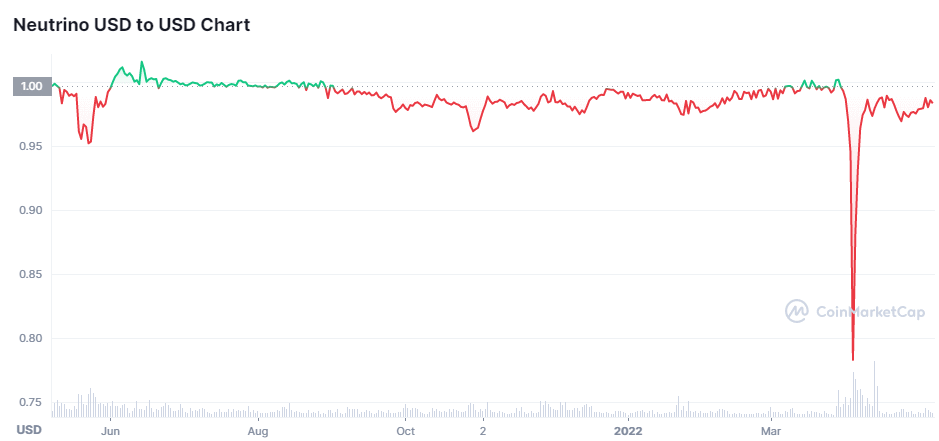What are algorithmic stablecoins in simple words?
Algorithmic stablecoins have replaced centralized stablecoins. We will tell you how these assets work and why you need them

07.05.2022
3857
12 min
1
In the spring of 2022, the TerraUSD algorithmic stablecoin entered the top 10 most capitalized cryptocurrencies for the first time in the history of the crypto industry. The share of such tokens in the digital asset market has been growing rapidly since 2020. This, among other things, is indicated by analyst data.
The chart shows the growth of the share of one of the most popular algorithmic stablecoins, DAI, compared with such simple (centralized) representatives of the asset class, as Tether (USDT) and USD Coin (USDC).

The editorial team of GetBlock Magazine decided to figure out what algorithmic stablecoins are and why such assets have become popular. We should begin our dive into the topic with the main thing: how tokens work. Therefore, the first step is to understand what stablecoins are and how market participants use such digital assets.
All statistics used in this article are dated May 4, 2022.
What are stablecoins?
The term “stablecoin” speaks for itself and refers to the stability of the exchange rate.
Stablecoins became a response to the high level of volatility of classic cryptocurrencies such as Bitcoin (BTC) and Ethereum (ETH). To get away from price fluctuations, the developers suggested pegging stablecoins to the rate of a traditional currency, a basket of currencies, an asset (including a digital one), or a basket of assets.
The easiest way to visualize the work of stablecoins is to compare the chart of the most capitalized representative of the “camp”, Tether, with such a highly volatile cryptocurrency as bitcoin:
- During the year, BTC managed to drop to $30 000, then broke through the $60 000 level, and after that dropped below $40 000.
- During the same period of time, the rate of USDT was near the level of $1.
Comparison of the bitcoin and Tether charts.
In total, the top 10 most capitalized cryptocurrencies include 3 stabelcoins: Tether (USDT), USD Coin (USDC), and the algorithmic TerraUSD (UST).
Why we need stablecoins
The stability of the exchange rate of such assets allows them to be used for various purposes. For example, you can use stablecoins to pay for goods and services with a fixed price, as well as to quickly transfer funds abroad. As a rule, transactions with stablecoins are cheaper and faster than those in the traditional financial market.
What are algorithmic stablecoins?
The most capitalized stablecoins, Tether and USD Coin, are centralized. Digital assets, their issuance, and turnover are controlled by parent companies.
The centralized approach implies that the projects have a single control center that can be influenced. It appears that the introduction of sanctions against the parent companies of stablecoins may affect the assets themselves. At the same time, the centralized system implies that users are forced to trust issuers in terms of providing tokens. This approach contradicts the principles of decentralization laid down by the creator of the first cryptocurrency, bitcoin, Satoshi Nakamoto.
An alternative to centralized stablecoins became their algorithmic (decentralized) counterparts. This stablecoin format is more in line with Satoshi Nakamoto's ideas and reflects the desire of market participants to bypass counterparty risk.
The rate of decentralized stablecoins is controlled by an algorithm. Such token systems are fully automated. MakerDAO (DAI) is considered to be the first algorithmic stablecoin. The project appeared in 2015.
How algorithmic stablecoins work
Let's look at how algorithmic stablecoins work, using the example of the most capitalized asset of the group, TerraUSD (UST). The developers pegged the exchange rate of the token to the US dollar. To ensure the stability of UST, the project team developed a scheme that includes forced additional issuance and token burning.
TerraUSD is influenced by the popularity of stabelcoins in the market. An increase in the number of users of the token pushes its rate up. A decrease in the popularity of the asset, on the contrary, pulls UST down. Additional issuance (when demand increases) and burning* (when demand decreases) help regulate the stablecoin exchange rate.
*In the cryptocurrency community, burning is the process of removing assets from circulation.
To understand how the system works, let's visualize it. Imagine that all TerraUSD stablecoins available on the market represent the bottom of a pool, the water level of which is the price of tokens. When the demand for UST increases, the rate of the digital asset (water level) begins to rise. It is possible to return the price to its original value ($1) through an increase in the pool area. This is done by issuing additional TerraUSD. Due to the redistribution of water considering the new area, the rate goes down to $1 again.

Shots from the TerraUSD video presentation
In case the price of UST falls, it is necessary to remove the excess area (burn extra stablecoins).
The production of the new TerraUSD is worth special attention. USTs are created from the native tokens of the Terra crypto project, LUNA. Here's how it works:
- Network users take $1 worth of LUNAs and convert them to 1 UST. Transactions can be made in the project's cryptocurrency wallet, Terra Station. The program is available in a variety of formats, from a browser extension to a mobile app. You can download the crypto wallet on the official website of the project.
- After converting LUNA to UST, users can sell the stablecoin in the cryptocurrency wallet.
Market participants are interested in the production of new TerraUSD because it is possible to make money on such operations. Let's look at an example:
The rate of a coin reached $1,1. At this point, user N decides to issue 10 new TerraUSD. They spend $10 in LUNA to do this. At the same time, they will be able to sell new USTs for $11 due to the increased rate, since the rate of stablecoin has reached $1,1. From the sale, N will earn a net of $1.
At times when the TerraUSD exchange rate falls, it is necessary to eliminate some of the stablecoins to balance the price. To do this, users convert UST back to LUNA. It is also possible to make money on such operations. Let's look at an example:
TerraUSD has fallen to $0,9. User N, who has 10 stablecoins, exchanges them for LUNA. The cryptocurrency wallet calculates the transaction at the rate of $1 per UST. As a result, N sells stablecoins, whose market rate is $0,9, for 10 cents more expensive. The user's net income will be $1.
Anyone can make money from stabilizing the UST exchange rate by creating new stablecoins or removing some of the tokens from the market. The main thing is to seize the moment for a profitable transaction.
Interesting! At the end of March 2022, the Terra team announced the purchase of $1 billion worth of bitcoins, and in early May it bought another $1,5 billion worth of BTC. Bitcoins, according to the developers, will help increase the sustainability of UST.
Other algorithmic stablecoins operate on a similar principle. Their main differences from conventional stablecoins include the abandonment of centralized control, the automation of systems, and often the involvement of users in the regulatory process.
The most popular algorithmic stablecoins are MakerDAO (DAI) and TerraUSD (UST). Their analogs include such projects as Vai (VAI), Ampleforth (AMPL), Neutrino USD (USDN), and Fei USD (FEI).
The algorithmic stablecoin market continues to grow. This includes many projects already popular in the market, which are joining the direction. So, at the end of April 2022, Justin Sun, head of the TRON Foundation, announced his intention to issue an algorithmic stablecoin.
Comparison of algorithmic and centralized stablecoin
Centralized |
Algorithmic |
|
Governance |
Control of the stablecoin is held by a team of its developers |
There is no single control center. Systems are automated and decentralized |
Collateralization |
Assets that are held in the reserves of the issuing company |
Assets that have been programmed by the developers. For example, the UST stablecoin is collateralized by LUNA. |
Fly in the ointment
Unfortunately, not all regulators are positive about stablecoins. Many regulators are concerned about the lack of tools to control the stablecoin market and about issues related to the security of stablecoins.
What is wrong with centralized stablecoins
One of the main complaints about centralized stablecoins is that issuers of such tokens typically fail to provide verified information about the collateral of digital assets. Scandals related to the volume of storage have not bypassed Tether.
Periodically, the issuer of USDT publishes reports on the security of stablecoins. One of the most recent was presented by the developers in August 2021. The problem is that the accounting companies, which conduct collateral analysis, work for Tether, and therefore are interested parties. There is no information about the audit of the reserves and confirmation of the company's reports by independent regulatory bodies.
Important! At the end of July 2021, the media reported that Tether was under investigation by the US Department of Justice (DOJ). The regulator suspects the company's representatives of bank fraud.
The lack of evidence of the collateralization of stablecoins, according to Gary Gorton, an economist at Yale University, and Jeffery Zhang, a representative of the US Federal Reserve System, may return America to the era of “wildcat banking.” This period of history is notorious for the uncontrolled flooding of the market with unsecured money. As a solution to the problem, the authors of the paper proposed strengthening the regulation of stablecoins.
Problems of algorithmic stablecoins
The abandonment of a centralized control system does not solve all of the problems of stablecoins. For example, Paolo Ardoino, CTO of Tether, believes that decentralized stablecoins can be dangerous in case of cascading position liquidations when tokens reach high capitalization figures.
Important! Paolo Ardoino is a representative of the competing “camp.” The businessman may benefit from the negative evaluation of algorithmic stablecoins, which, as statistics show, are gradually strengthening their positions in the market of stablecoins.
Also, decentralized stablecoins were criticized by Vivian Fang, a professor of accounting at the University of Minnesota's Carlson School of Management. In her opinion, market participants should not blindly trust algorithms. She was also alerted by the refusal of the developers of such digital assets from the traditional system of collateralizing tokens with reserves.
Dr. Ryan Clements identified several other problems of algorithmic stablecoins. He singled out three points as disadvantages of such assets:
- Decentralized stablecoins depend on demand levels.
- Systems of such assets rely on independent entities with no legal obligations, making them vulnerable.
- It is unknown how decentralized stablecoins will behave during a crisis.
“These uncollateralized digital assets, [developers of which] attempt to peg the price of a reference asset using financial engineering, algorithms, and market incentives, are not stable at all but exist in a state of perpetual vulnerability,” he noted.
Interesting! In the history of the market, there have been cases when algorithmic stablecoins lost their pegging to the main asset. This is what happened with Neutrino (USDN) in early April 2022. The stablecoin deviated 15% from the WAVES cryptocurrency to which it is pegged. WAVES founder Alexander Ivanov blamed the incident on Alameda Research, which is headed by one of the richest people in the crypto industry according to Forbes, Sam Bankman-Fried. According to the developer, the organization directed its resources to collapse the USDN rate.
Neutrino (USDN) chart.

Where to buy stablecoins for rubles
Under the sanctions pressure, buying cryptocurrencies is fraught with a number of difficulties. On most popular crypto exchanges, Russian citizens can buy coins through P2P platforms. The method implies a transaction with another market participant directly, without intermediaries.
You can buy stablecoins for rubles, for example, on the Russified cryptocurrency exchanges Binance and KuCoin. Both platforms have P2P platforms.
Summing up
Algorithmic stablecoins are digital assets whose rate stability is regulated by an algorithm. This scheme has both advantages and disadvantages. For example, decentralized stablecoins are not subject to regulatory pressure. It can be assumed that their independence became one of the reasons for the growth of demand for such assets. At the same time, the safety of algorithmic stablecoins has not been fully proven.
Useful material?
Basics
Why Satoshi Nakamoto’s technical manifesto for a decentralized money system matters
Oct 31, 2022
Basics
Experts evaluated the development prospects of the new ecosystem and the investment attractiveness of its token
Oct 20, 2022
Basics
How to track fluctuations correctly and create an effective income strategy
Sep 13, 2022
Basics
Review of the most profitable offers from proven trading platforms
Aug 29, 2022
Basics
The Ethereum Foundation team has published a breakdown of major misconceptions about the upcoming network upgrade
Aug 18, 2022
Basics
What benefits the exchange offers, and what else is in the near future
Aug 4, 2022










 Telegram
Telegram  Twitter
Twitter